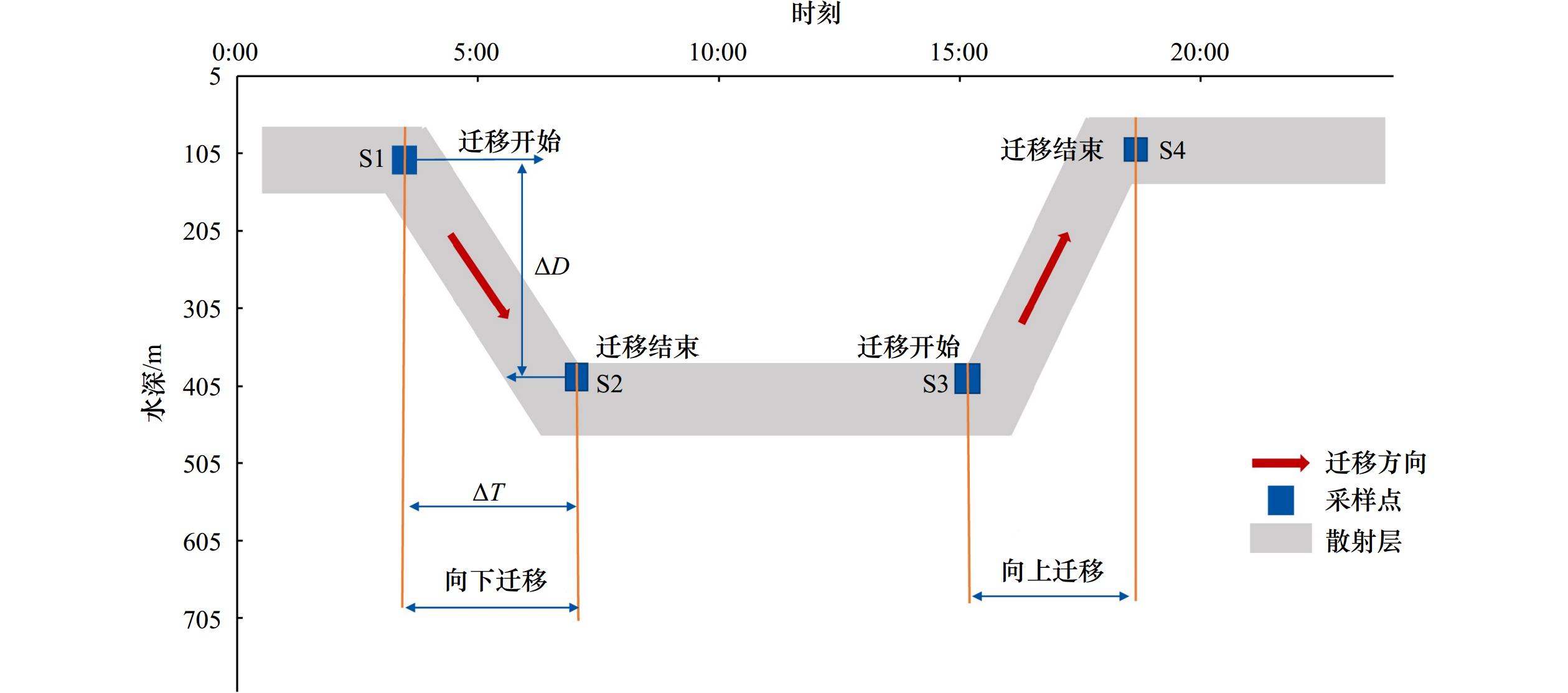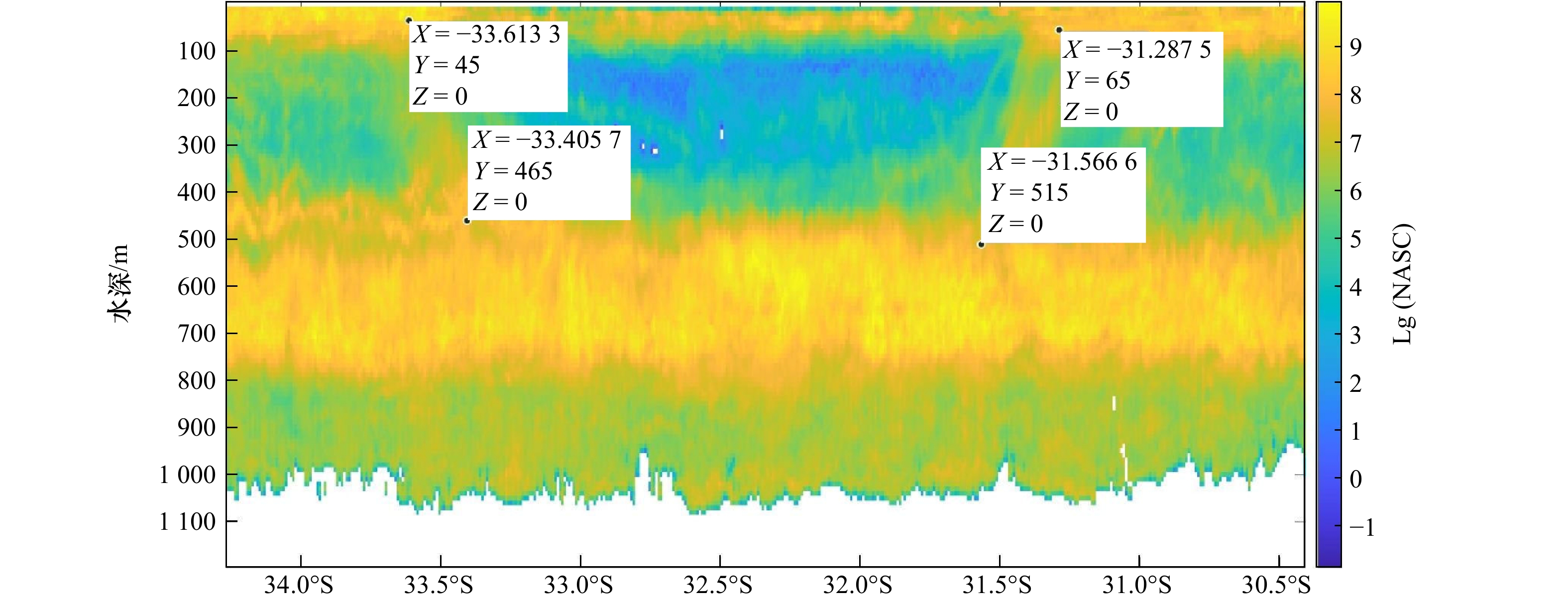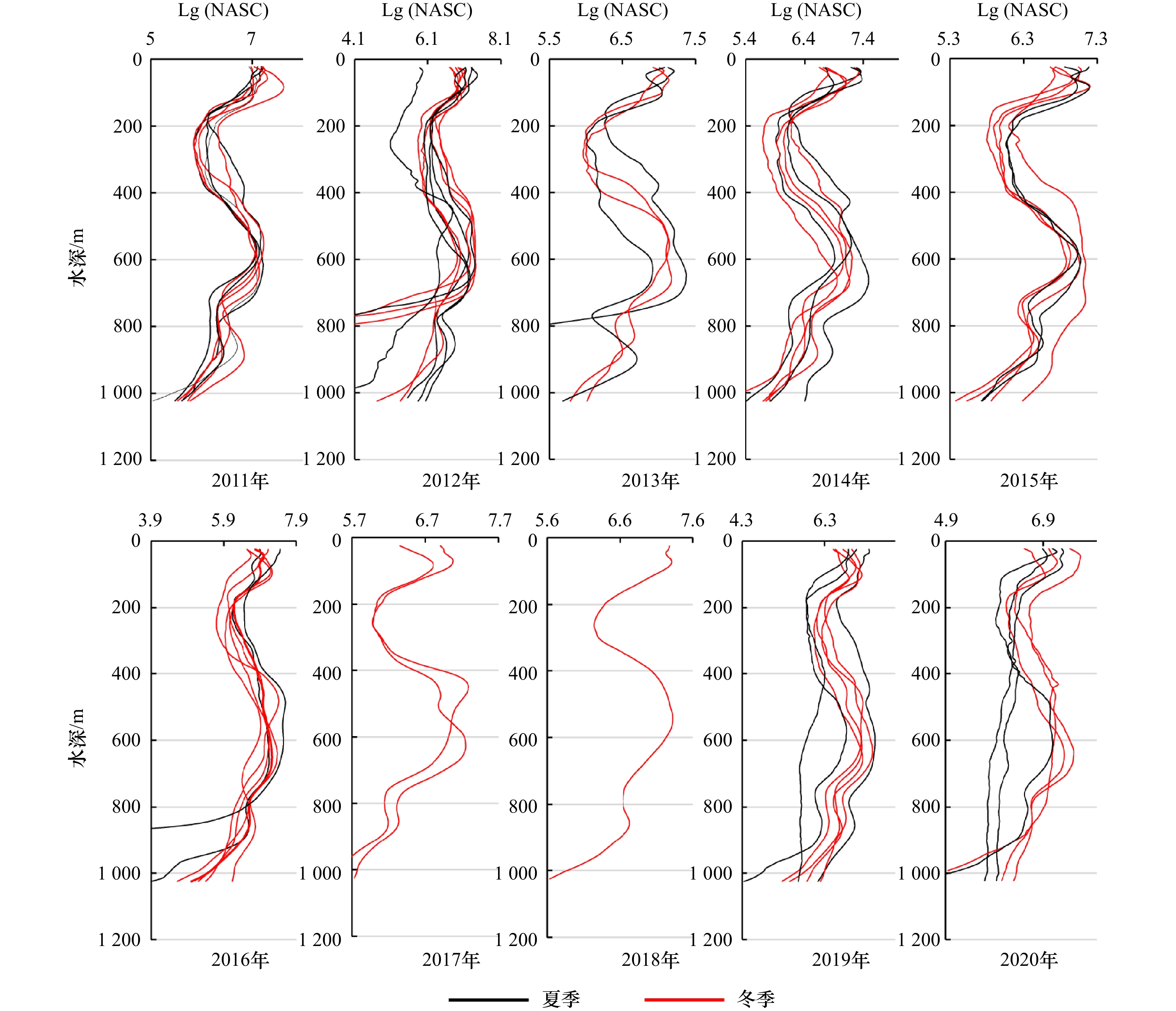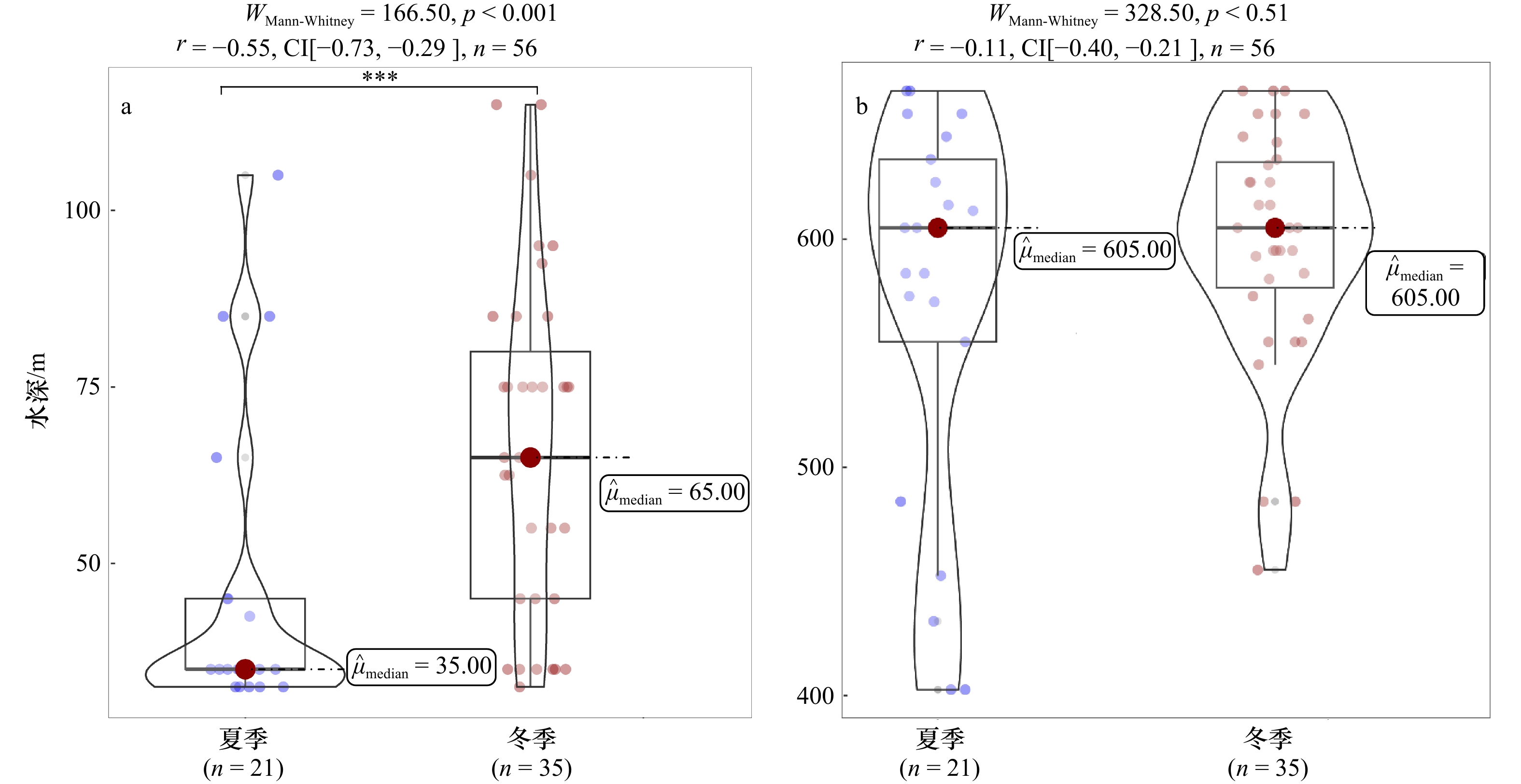Study on the diel vertical migration characteristics of the deep scattering layer in the southwestern Indian Ocean
-
摘要: 本研究根据2011−2020年西南印度洋56个声学断面数据观察到的深海散射层201次昼夜垂直迁移现象,分析了其昼夜垂直迁移特征及时空差异。研究结果表明,该海域散射层具有分层现象,第一散射层位于200 m以浅水层,其海洋面积散射系数(NASC)峰值的平均水深为(58.66 ± 24.63)m,夏季和冬季之间存在显著性差异(p < 0.001);第二散射层位于400~700 m水层,其NASC峰值的平均水深为(589.02 ± 66.33)m,夏季和冬季之间无显著性差异(p = 0.51)。散射层向上迁移的开始时间平均为16:20,结束迁移的平均时间为18:31,迁移的平均速率为(5.28 ± 1.53)cm/s;向下迁移的开始时间平均为4:38,结束迁移的平均时间为6:52,迁移的平均速率为(5.56 ± 2.13)cm/s。随着纬度的增加,散射层向下迁移的开始时间变晚,迁移速率变慢;随着经度的增加,散射层迁移速率变慢,且不同经度海域之间存在显著性差异(p < 0.001)。分析认为,研究海域理化环境的季节性变化以及散射层中生物的不同生活史阶段是造成散射层垂直结构和昼夜垂直迁移特征时空差异的主要原因,其对解释金枪鱼的昼夜垂直迁移行为和指示金枪鱼渔场分布等具有重要意义。Abstract: Based on the data from 56 acoustic survey sections in the southwestern Indian Ocean from 2011 to 2020, a total of 201 diel vertical migration were observed. The characteristics of diel vertical migration of the deep scattering layer and its spatiotemporal differences were analyzed. The research results show that the deep scattering layer in the southwestern India Ocean exhibits a stratification phenomenon, with the first scattering layer located in the shallow water layer below 200 m. The average depth of its nautical area scattering coefficient (NASC) peak is (58.66 ± 24.63) m, and there is a significant difference between summer and winter (p < 0.001); the second scattering layer is located in the water layer between 400 m and 700 m, with an average depth of (589.02 ± 66.33) m for its NASC peak. There is no significant difference between summer and winter (p = 0.51). The average time for the scattering layer to migrate upwards is 16:20, the average time for the end of migration is 18:31, and the average migration rate is (5.28 ± 1.53) cm/s; the average time for the scattering layer to start migrating downwards is 4:38, and the average time for the end of migration is 6:52. The average migration rate is (5.56 ± 2.13) cm/s. As latitude increases, the start time of downward migration become later and the migration rate slows down; as the longitude increases, the migration rate of the scattering layer also slows down, and there is a significant difference between different longitude sea areas (p < 0.001). Analysis suggests that studying the seasonal changes in the physical and chemical environment of the sea area, as well as the different life cycle stages of organisms in the scattering layer, are the main reasons for the spatiotemporal differences in the vertical structure and diurnal vertical migration characteristics of the scattering layer. They are of great significance in explaining the diurnal vertical migration behavior of tuna and indicating the distribution of tuna fishing grounds.
-
图 8 NASC峰值所处水深的分布与Mann-Whitney U 检验
a. 第一峰值;b. 第二峰值。WMann-Whitney表示样本秩的和;p表示显著性水平;$\hat{r}^{{\mathrm{rank}}}_{\mathrm{biserial}} $表示样本之间的相关系数;CI95%表示95%的置信区间;nobs表示样本中的观测值总数;$\hat{\mu}_{\mathrm{median}} $表示样本的中位数
Fig. 8 Depth distribution and Mann-Whitney U test results of the NASC peak
a. The first peak; b. the second peak. WMann-Whitney represents the sum of samples’ order; p represents the level of significance; $\hat{r}^{{\mathrm{rank}}}_{\mathrm{biserial}} $ represents the correlation coefficient between samples; CI95% represents a 95% confidence interval; nobs represents the total number of observation samples; $\hat{\mu}_{\mathrm{median}} $ represents the median of samples
表 1 深海散射层向上迁移的特征值
Tab. 1 Upward migration characteristics of DSL
季节 样本数量 开始时间(T1) 结束时间(T2) 迁移速率/(cm·s−1) 均值 最大值 最小值 均值 最大值 最小值 均值 最大值 最小值 整体 201 16:20 18:43 13:06 18:31 20:41 16:29 5.28 ± 1.53 10.66 2.2 夏季 86 16:50 18:43 14:31 19:08 20:41 17:45 5.11 ± 1.48 9.59 2.2 冬季 115 15:57 17:21 13:06 18:03 19:29 16:29 5.42 ± 1.55 10.66 2.31 表 2 深海散射层向下迁移的特征值
Tab. 2 Downward migration characteristics of DSL
季节 样本数量 开始时间(T1) 结束时间(T2) 迁移速率/(cm·s−1) 均值 最大值 最小值 均值 最大值 最小值 均值 最大值 最小值 整体 201 4:38 6:20 1:22 6:52 9:56 3:23 5.56 ± 2.13 12.26 1.44 夏季 86 4:02 5:33 1:22 6:18 9:56 3:23 5.55 ± 2.23 11.33 2.41 冬季 115 5:06 6:20 3:05 7:17 9:29 5:10 5.57 ± 2.06 12.26 1.44 表 3 不同纬度海区深海散射层昼夜垂直迁移特征值
Tab. 3 Characteristics of DVM in different latitude regions of DSL
迁移方向 纬度范围 样本数量 开始时间(T1) 结束时间(T2) 迁移速率/(cm·s−1) 均值 最大值 最小值 均值 最大值 最小值 均值 最大值 最小值 向上迁移 20°~31°S 124 16:20 18:22 14:00 18:37 20:41 17:10 5.50 ± 1.26 9.59 2.49 31°~43°S 71 16:23 18:43 13:06 18:25 20:41 16:38 4.99 ± 1.86 10.66 2.2 向下迁移 20°~31°S 127 4:30 6:10 2:24 6:49 9:56 4:19 5.98 ± 2.05 12.26 2.82 31°~43°S 72 4:52 6:20 1:22 6:56 9:12 3:23 4.86 ± 2.12 11.01 1.44 表 4 不同经度深海散射层昼夜垂直迁移特征值
Tab. 4 Characteristics of DVM in different longitude regions of DSL
迁移方向 经度范围 样本数量 开始时间(T1) 结束时间(T2) 迁移速率/(cm·s−1) 均值 最大值 最小值 均值 最大值 最小值 均值 最大值 最小值 向上迁移 44°~52.5°E 13 16:39 18:11 15:18 18:25 19:52 17:44 6.36 ± 1.15 8.58 4.62 52.5°~67.5°E 157 16:20 18:43 13:06 18:31 20:41 16:38 5.31 ± 1.58 10.66 2.2 82.5°~97.5°E 26 16:09 17:04 14:51 18:31 19:47 16:29 4.71 ± 1.18 7.67 2.46 向下迁移 44°~52.5°E 12 4:41 5:35 3:09 6:39 7:46 4:43 6.82 ± 2.38 12.26 3.86 52.5°~67.5°E 157 4:41 6:20 1:22 6:53 9:56 3:23 5.62 ± 2.08 11.79 1.44 82.5°~97.5°E 27 4:24 5:49 2:24 6:49 9:12 4:19 4.88 ± 2.14 10 1.64 -
[1] Dawidowicz P, Pijanowska J, Ciechomski K. Vertical migration of Chaoborus larvae is induced by the presence of fish[J]. Limnology & Oceanography, 1990, 35(7): 1631−1637. [2] Roe H S J. Observations on the diurnal vertical migrations of an oceanic animal community[J]. Marine Biology, 1974, 28(2): 99−113. doi: 10.1007/BF00396301 [3] Han Boping, Straškraba M. Modeling patterns of zooplankton diel vertical migration[J]. Journal of Plankton Research, 1998, 20(8): 1463−1487. doi: 10.1093/plankt/20.8.1463 [4] Bianchi D, Mislan K A S. Global patterns of diel vertical migration times and velocities from acoustic data[J]. Limnology & Oceanography, 2016, 61(1): 353−364. [5] Postel L, da Silva A J, Mohrholz V, et al. Zooplankton biomass variability off Angola and Namibia investigated by a lowered ADCP and net sampling[J]. Journal of Marine Systems, 2007, 68(1/2): 143−166. [6] Valle-Levinson A, Castro L, Cáceres M, et al. Twilight vertical migrations of zooplankton in a Chilean fjord[J]. Progress in Oceanography, 2014, 129: 114−124. doi: 10.1016/j.pocean.2014.03.008 [7] Benoit-Bird K J, Moline M A, Southall B L. Prey in oceanic sound scattering layers organize to get a little help from their friends[J]. Limnology & Oceanography, 2017, 62(6): 2788−2798. [8] Duvall G E, Christensen R J. Stratification of sound scatterers in the ocean[J]. The Journal of the Acoustical Society of America, 1946, 18(1S): 254. [9] Letessier T B, De Grave S, Boersch-Supan P H, et al. Seamount influences on mid-water shrimps (Decapoda) and gnathophausiids (Lophogastridea) of the South-West Indian Ridge[J]. Deep-Sea Research Part II: Topical Studies in Oceanography, 2017, 136: 85−97. doi: 10.1016/j.dsr2.2015.05.009 [10] Pakhomov E A, Froneman P W. Composition and spatial variability of macroplankton and micronekton within the Antarctic Polar Frontal Zone of the Indian Ocean during austral autumn 1997[J]. Polar Biology, 2000, 23(6): 410−419. doi: 10.1007/s003000050462 [11] Rogers A D, Alvheim O, Bemanaja E, et al. Pelagic communities of the South West Indian Ocean seamounts: R/V Dr Fridtjof Nansen Cruise 2009-410[J]. Deep-Sea Research Part II: Topical Studies in Oceanography, 2017, 136: 5−35. doi: 10.1016/j.dsr2.2016.12.010 [12] Clark C W, Levy D A. Diel vertical migrations by juvenile sockeye salmon and the antipredation window[J]. The American Naturalist, 1988, 131(2): 271−290. doi: 10.1086/284789 [13] Koslow J A, Kloser R J, Williams A. Pelagic biomass and community structure over the mid-continental slope off southeastern Australia based upon acoustic and midwater trawl sampling[J]. Marine Ecology Progress Series, 1997, 146(1/3): 21−35. [14] Bianchi D, Galbraith E D, Carozza D A, et al. Intensification of open-ocean oxygen depletion by vertically migrating animals[J]. Nature Geoscience, 2013, 6(7): 545−548. doi: 10.1038/ngeo1837 [15] Steinberg D K, Carlson C A, Bates N R, et al. Zooplankton vertical migration and the active transport of dissolved organic and inorganic carbon in the Sargasso Sea[J]. Deep-Sea Research Part I: Oceanographic Research Papers, 2000, 47(1): 137−158. doi: 10.1016/S0967-0637(99)00052-7 [16] 孙栋, 王春生. 深远海浮游动物生态学研究进展[J]. 生态学报, 2017, 37(10): 3219−3231.Sun Dong, Wang Chunsheng. A review of open ocean zooplankton ecology[J]. Acta Ecologica Sinica, 2017, 37(10): 3219−3231. [17] 李琦, 陈朝晖. 基于ADCP回声的黑潮−亲潮混合区浮游动物昼夜垂直迁移研究[J]. 海洋与湖沼, 2022, 53(2): 305−319. doi: 10.11693/hyhz20211000250Li Qi, Chen Zhaohui. Diel vertial migration of zooplankton in the Kuroshio-Oyashio mixed zone based on ADCP echo[J]. Oceanologia et Limnologia Sinica, 2022, 53(2): 305−319. doi: 10.11693/hyhz20211000250 [18] Han Boping, Straškraba M. Control mechanisms of diel vertical migration: theoretical assumptions[J]. Journal of Theoretical Biology, 2001, 210(3): 305−318. doi: 10.1006/jtbi.2001.2307 [19] Zaret T M, Suffern J S. Vertical migration in zooplankton as a predator avoidance mechanism[J]. Limnology & Oceanography, 1976, 21(6): 804−813. [20] McLaren I A. Effects of temperature on growth of zooplankton, and the adaptive value of vertical migration[J]. Journal of the Fisheries Research Board of Canada, 1963, 20(3): 685−727. doi: 10.1139/f63-046 [21] Boersch-Supan P H, Rogers A D, Brierley A S. The distribution of pelagic sound scattering layers across the Southwest Indian Ocean[J]. Deep-Sea Research Part II: Topical Studies in Oceanography, 2017, 136: 108−121. doi: 10.1016/j.dsr2.2015.06.023 [22] Kloser R J, Ryan T E, Young J W, et al. Acoustic observations of micronekton fish on the scale of an ocean basin: potential and challenges[J]. ICES Journal of Marine Science, 2009, 66(6): 998−1006. doi: 10.1093/icesjms/fsp077 [23] Lebourges-Dhaussy A, Marchal É, Menkès C, et al. Vinciguerria nimbaria (micronekton), environment and tuna: their relationships in the eastern Tropical Atlantic[J]. Oceanologica Acta, 2000, 23(4): 515−528. doi: 10.1016/S0399-1784(00)00137-7 [24] Haris K, Kloser R J, Ryan T E, et al. Sounding out life in the deep using acoustic data from ships of opportunity[J]. Scientific Data, 2021, 8(1): 23. doi: 10.1038/s41597-020-00785-8 [25] Ryan T E, Downie R A, Kloser R J, et al. Reducing bias due to noise and attenuation in open-ocean echo integration data[J]. ICES Journal of Marine Science, 2015, 72(8): 2482−2493. doi: 10.1093/icesjms/fsv121 [26] MacLennan D N, Fernandes P G, Dalen J. A consistent approach to definitions and symbols in fisheries acoustics[J]. ICES Journal of Marine Science, 2002, 59(2): 365−369. doi: 10.1006/jmsc.2001.1158 [27] Proud R, Handegard N O, Kloser R J, et al. From siphonophores to deep scattering layers: uncertainty ranges for the estimation of global mesopelagic fish biomass[J]. ICES Journal of Marine Science, 2019, 76(3): 718−733. doi: 10.1093/icesjms/fsy037 [28] Aksnes D L, Røstad A, Kaartvedt S, et al. Light penetration structures the deep acoustic scattering layers in the global ocean[J]. Science Advances, 2017, 3(5): e1602468. doi: 10.1126/sciadv.1602468 [29] Røstad A, Kaartvedt S, Aksnes D L. Light comfort zones of mesopelagic acoustic scattering layers in two contrasting optical environments[J]. Deep-Sea Research Part I: Oceanographic Research Papers, 2016, 113: 1−6. doi: 10.1016/j.dsr.2016.02.020 [30] Inoue R, Kitamura M, Fujiki T. Diel vertical migration of zooplankton at the S1 biogeochemical mooring revealed from acoustic backscattering strength[J]. Journal of Geophysical Research: Oceans, 2016, 121(2): 1031−1050. doi: 10.1002/2015JC011352 [31] Wishner K F, Gowing M M, Gelfman C. Mesozooplankton biomass in the upper 1 000 m in the Arabian Sea: overall seasonal and geographic patterns, and relationship to oxygen gradients[J]. Deep-Sea Research Part II: Topical Studies in Oceanography, 1998, 45(10/11): 2405−2432. [32] Conover R J. Comparative life histories in the genera Calanus and Neocalanus in high latitudes of the northern hemisphere[J]. Hydrobiologia, 1988, 167(1): 127−142. [33] Miller C B, Clemons M J. Revised life history analysis for large grazing copepods in the subarctic Pacific Ocean[J]. Progress in Oceanography, 1988, 20(4): 293−313. doi: 10.1016/0079-6611(88)90044-4 [34] Dawson J K. Vertical distribution of Calanus hyperboreus in the central Arctic Ocean[J]. Limnology & Oceanography, 1978, 23(5): 950−957. [35] 刘顺会, 孙松, 韩博平. 浮游动物昼夜垂直迁移机理的主要假说及其研究进展[J]. 生态科学, 2008, 27(6): 515−521. doi: 10.3969/j.issn.1008-8873.2008.06.014Liu Shunhui, Sun Song, Han Boping. Hypotheses and theories of mechanisms underlying the diel vertical migration of zooplankton: a review[J]. Ecological Science, 2008, 27(6): 515−521. doi: 10.3969/j.issn.1008-8873.2008.06.014 [36] Cohen J H, Forward R B Jr. Zooplankton Diel Vertical Migration—A Review of Proximate Control[M]. Boca Raton: CRC Press, 2009, 47: 77−109. [37] Tarling G A, Matthews J B L, David P, et al. The swarm dynamics of northern krill ( Meganyctiphanes norvegica) and pteropods ( Cavolinia inflexa) during vertical migration in the Ligurian Sea observed by an acoustic Doppler current profiler[J]. Deep-Sea Research Part I: Oceanographic Research Papers, 2001, 48(7): 1671−1686. doi: 10.1016/S0967-0637(00)00105-9 [38] Staby A, Aksnes D L. Follow the light—diurnal and seasonal variations in vertical distribution of the mesopelagic fish Maurolicus muelleri[J]. Marine Ecology Progress Series, 2011, 422: 265−273. doi: 10.3354/meps08938 [39] Plueddemann A J, Pinkel R. Characterization of the patterns of diel migration using a Doppler sonar[J]. Deep-Sea Research Part A: Oceanographic Research Papers, 1989, 36(4): 509−530. doi: 10.1016/0198-0149(89)90003-4 [40] Dagorn L, Bach P, Josse E. Movement patterns of large bigeye tuna ( Thunnus obesus) in the open ocean, determined using ultrasonic telemetry[J]. Marine Biology, 2000, 136(2): 361−371. doi: 10.1007/s002270050694 [41] Reid S B, Hirota J, Young R E, et al. Mesopelagic-boundary community in Hawaii: micronekton at the interface between neritic and oceanic ecosystems[J]. Marine Biology, 1991, 109(3): 427−440. doi: 10.1007/BF01313508 -




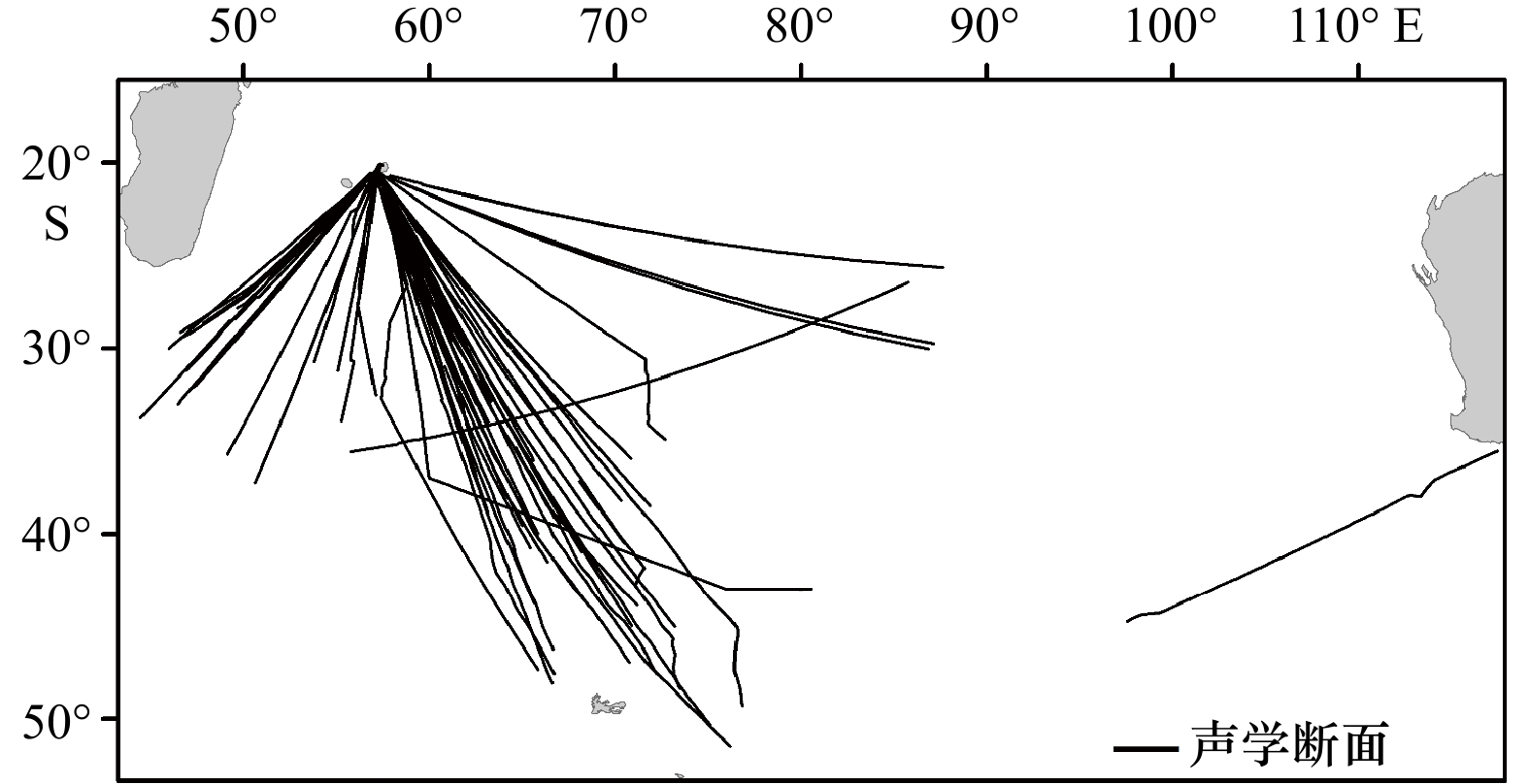
 下载:
下载:

